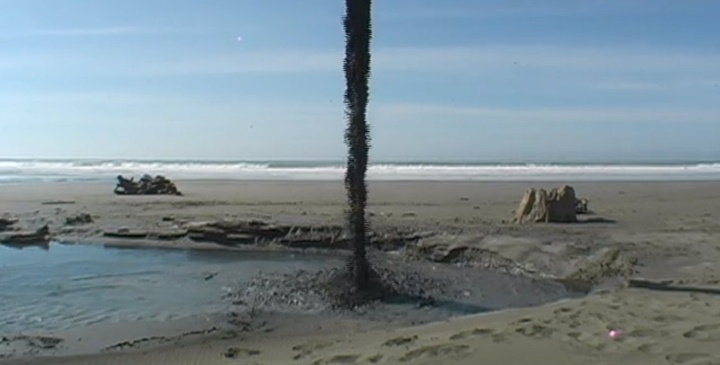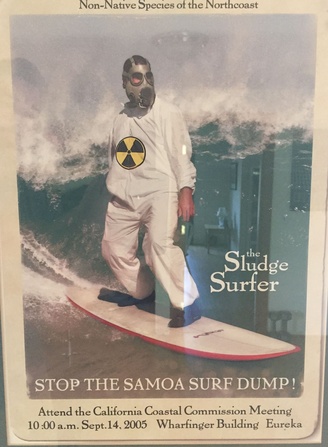
Still from Cynthia Hooper’s short film “Bay Dredge.”
Nearly
a decade ago, a lack of planning combined with a dire need for
dredging in Humboldt Bay erupted into controversy. While everyone
agreed the channels needed to be cleared, the proposed dumping of
dredge
material on Samoa Beach
divided the community with fishermen on one side and recreational
beach goers on the other.
Today we find ourselves in almost the exact same situation. Dredging of Humboldt Bay has once again become an undeniably urgent matter, and Samoa Beach has once again been proposed as the best disposal option. Unfortunately, despite having 10 years to find a long-term solution, the Humboldt Bay Harbor District and City of Eureka are just beginning to present to the public options for disposing of dredge spoils from their marinas.
Back in 2007, the Harbor District insisted on ignoring EPA guidance and instead asked to dump 200,000 cubic yards of bay sludge on Samoa Beach a popular surf spot and access point known as “Power Poles.” Due to the state of emergency the district had allowed to happen, the California Coastal Commission reluctantly approved the pumping of bay mud through a pipe over the dunes, where it spewed out onto Samoa Beach. But the Commission, along with the U.S. EPA and California Dept. of Fish & Wildlife, made clear that any future projects must be better planned and that a similar project would not be a viable option. In 2008, the Coastal Commission reasserted this stance (No dredge spoils on beach, agency insists – Eureka Times-Standard).

With so much disapproval from permitting agencies and the public last time around, why is Samoa Beach even being considered an option for dumping again? In his presentation to the Eureka City Council on Tuesday, Eureka Parks and Recreation Director Miles Slattery described Samoa Beach as being “the best option” for disposal due to the comparatively low cost, its ability to accommodate high volumes of dredge material and being the “least environmentally damaging feasible alternative.” He also briefly described other possible locations for the dredge spoils, including:
- Using it as fill for wetland restoration projects,
- Open ocean disposal at the approved site three miles offshore,
- “Flow-lane” disposal,
- Ocean disposal through the Redwood Marine Terminal’s 1½ mile long outfall,
- Upland disposal at one of two sites on the North Spit,
- And the temporary outfall at Samoa Beach.
The reality is, however, in addition to ignoring all previous agency guidance, dumping thousands of gallons on Eureka’s most popular and accessible beach is cause for significant concern. As we know from last time this happened, the impacts to public access are significant – in 2007, the river of sludge created a barrier impassable to the beachcombers, runners, dog walkers, horseback riders and others who utilize Samoa and Manila beaches daily. If such a situation happens again, the City of Eureka and Humboldt Harbor District could be in violation of California’s Coastal Act, which guarantees coastal access to all.
The current proposed beach location in Slattery’s presentation is about a mile south of Power Poles parking lot, chosen because of its “minimal recreational impacts.” Commonly referred to by surfers as “Water Tanks” (because of the water tank across the street) the location is now just as popular – if not more – than Power Poles was 10 years ago. The entire Samoa Peninsula in general is one of the most utilized beaches in Humboldt County.
Judging by the full house at both the Harbor District and Eureka City Council meetings, this issue has just as much public interest as last time. Fishermen, boat owners, surfers, beachgoers and environmentalists filled the audience at both meetings and many spoke during public comment. All parties agreed that dredging needs to happen as quickly as possible – but division still exists as to how best make it happen, with many people caught in the middle.
Feeling unfairly stuck between a rock and a hard place is mariner, surfer, and fisheries major Libby Tonning. “It is frustrating and a bummer that they didn’t get their act together and do their job sooner,” Tonning said. “But unfortunately this is where we are at now, and we are down to the wire. I hate the beach solution, but I also hate the idea of the marinas wasting away.”
“Some progress has been made since 2007 – the Harbor District now owns a dredge and the ocean outfall at the former pulp mill. But much more needs to be done to develop a long-term solution,” said Jennifer Kalt, Director of Humboldt Baykeeper. “Putting forward a plan to dump spoils on Samoa Beach yet again was premature, since the permitting agencies have not yet been consulted.”
The outcome of both the Harbor District meeting and Eureka City Council meeting was to sit down with the permitting agencies to further discuss options. Further technical studies may be necessary to obtain the necessary state and federal permits, and it seems premature to declare beach disposal the “least environmentally damaging” before all of the alternatives are more thoroughly analyzed. Test results for dioxin and other contaminants are not in yet for all of the areas to be dredged this time around, but contamination will have to be considered regardless of which disposal site is used.
Ultimately, the permit application will come before the Coastal Commission, which has the authority to approve as submitted, approve with added conditions or to deny. “It’s worth noting that last time the Commission voted on this project, it only passed by one vote – and with the understanding that it would not be approved in such a way again,” said Jennifer Savage, Surfrider Foundation California Policy Manager. “We truly hope that the City of Eureka and the Humboldt Harbor District move ahead with an option likely to be approved.”
With all parties sharing a common interest in the well-being of Humboldt Bay and the surrounding coastline and ocean, it is unfair a lack of planning is pitting constituents against each other. Hopefully, lessons learned from last time will help avoid unnecessary controversy and lead to a solution as quickly as possible.
Video by College of the Redwoods professor and artist Cynthia Hooper. “The video does not advocate one way or another about the issue,” says Hooper. ‘It simply visually described the effect of beach disposal in 2007.”
###
Delia Bense-Kang serves as the Northcoast Environmental Center’s Marine Protected Area Outreach Coordinator and chairs Surfrider Foundation’s Humboldt Chapter.
CLICK TO MANAGE